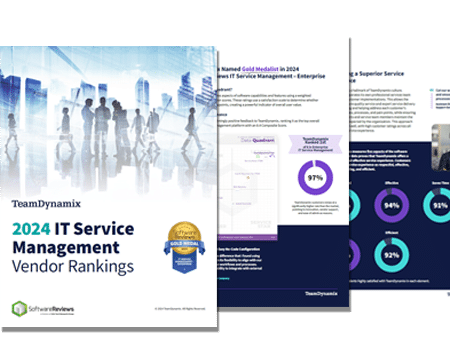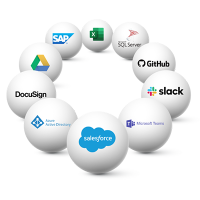
Gainesville Regional Utilities Improves IT Service with Advanced Automation and Integration
Gainesville Regional Utilities (GRU), a multi-service utility owned by the City of Gainesville, uses TeamDynamix for ITSM and iPaaS.

The Info-Tech ranking report offers a unique view of the market based entirely on in-depth customer interviews. Download the Info-Tech ITSM Quadrant and Customer Viewpoint report today.

We’ll show you some of our best situations and show you exactly how to execute them to get immediate results. The best part is, iPaaS tools often feature easy-to-use click and drag functionality, meaning you don’t need a dedicated employee building integrations and workflows.

System Integrators, Value Added Resellers, Technology Providers, and Buying Consortiums can benefit from a partnership with TeamDynamix.

The Info-Tech ranking report offers a unique view of the market based entirely on in-depth customer interviews. Download the Info-Tech ITSM Quadrant and Customer Viewpoint report to gain a better understanding of key vendor strengths and emerging market requirements.
In today’s rapidly evolving IT environment, agility is key. Being able to pivot quickly in response to conditions that are constantly changing allows IT service operations to address the needs of users more effectively.
Saint Louis University (SLU), a private Jesuit research university with 14,000 students and 9,700 faculty and staff, has met this requirement with the help of TeamDynamix, an easy-to-use, no-code platform for managing the service desk, projects, assets and enterprise service for HR, Facilities and more.
What caught my eye was the no-code nature of the platform, because that meant we could have anybody administer it without programming knowledge.
- Cid Cardoz, Director of End-user IT Services
Prior to TeamDynamix, SLU was using another tool for IT service management (ITSM), but the product was complex and hard to manage. Configuring the system required specialized coding ability, and the university struggled to hire and retain the staff needed to administer it.
As a result, when IT service leaders wanted to make changes to the system, they would contract this work out to a third-party provider. “It would take at least a month to get any changes completed,” says Cid Cardoz, director of end-user IT services for the university. “We were willing to go back to the drawing board to see if we could find a solution that worked better for our needs.”
Through his research, Cardoz found TeamDynamix. “What caught my eye was the no-code nature of the platform, because that meant we could have anybody administer it without programming knowledge,” he observes.
Now, Cardoz and his team don’t have to wait months to make changes, “we’re able to make changes on the fly and come up with solutions very quickly,” he says. “We have been making changes ever since we started using the system, adding new services to our service catalog—and the platform’s no-code nature makes this so much easier.”
What used to take a month now only takes two or three days, Cardoz says.

Integration and Automation Platform (iPaaS) Simplifies Integration to the IT Service Ecosystem
Another aspect of TeamDynamix that Cardoz and his team really appreciate is its Integrated Platform as a Service (iPaaS) capability. This codeless integration platform includes out-of-the-box connectors to popular systems such as Workday, Office365, Active Directory, Amazon Web Services, and more. With iPaaS, organizations can easily build integrations and automated workflows connecting various technology systems using a codeless, drag-and-drop visual workflow builder, streamlining the delivery of services even further. The platform can be used to facilitate integration and workflow around any ecosystem such as Salesforce for marketing, or HRIS for HR.
For instance, SLU has used iPaaS to create an automated workflow for adding users to Active Directory groups. When someone submits a request, it goes through an approval process—and then the user is added to the appropriate Active Directory group automatically, without the need for any manual intervention.
“iPaaS allows us to be more efficient in our workflows and processes,” says Tom Birmingham, an ITSM specialist for the university.
Configuration Ease and Flexibility is a Big Win
Cardoz describes the flexibility to make changes quickly as “a very big win for us.”
“If something isn’t working right on an old service request form,” Birmingham explains, “we can easily make a change to allow for a better workflow for our users.”
The streamlining of workflows through automation and process improvements has saved time for IT service employees. As a result, they’re able to close more tickets and provide better service for constituents. “That’s a big win for our customers as well,” Birmingham says.
In addition, the insights that leaders are able to glean from TeamDynamix analytics allow them to manage employees and resources more effectively. The platform “gives leaders the capability to understand each team’s workload and put business cases together to argue for more resources if necessary,” Cardoz says.
With all of these benefits, encouraging other university departments to adopt TeamDynamix for managing their own service requests has been an easy sell. Enterprise Service Management expansion has included HR, Enrollment, Admissions and Finance.
Taking the Service Desk to a New Level
Implementing a new ITSM platform can be challenging, but Birmingham called the TeamDynamix implementation “a great experience.”
“It was a little hard for me in the beginning,” he explains, “because I was a fish out of water working with ITSM. Thankfully, with the guidance of the TeamDynamix implementation team, the learning that took place from the ground up was very helpful. Their patience was amazing, and their knowledge of all aspects of the tool was astounding. They were able to answer questions about our processes and how to improve those using TeamDynamix. Their ability to think outside the box and show how we could configure the tool to mimic the success of other organizations was incredible.”
Within a few months, SLU had rolled out TeamDynamix with a service catalog of some 30 to 40 different types of service requests. Currently, Cardoz and his team are implementing the platform’s asset management features, and when that’s done they will configure the tool for managing projects as well.
“From an ITSM perspective, my goal is to have users request services through the tool’s self-service portal instead of reaching out directly to us,” Cardoz says. “We’re trying to push users there today. The way to do that is to make it simple and convenient by giving them different ways to put in their service requests.”
At Saint Louis University, TeamDynamix has improved efficiency and given leaders greater insight into the delivery of IT service, resulting in a much more connected enterprise.
“We have our future in our hands with TeamDynamix,” Birmingham concludes. “It’s been a very valuable tool for us.”

Gainesville Regional Utilities (GRU), a multi-service utility owned by the City of Gainesville, uses TeamDynamix for ITSM and iPaaS.

Combining ITSM with automation and integration (iPaaS) on a single, codeless platform is helping NaphCare improve its IT service desk.

CUSTOMER SPOTLIGHT Shaner Hotel Group Levels Up IT Service Management with Improved Self-Service Portal, No Code Workflow and Better Ticket Triage Customer service is the
TeamDynamix’s award-winning SaaS cloud solution offers IT Service and Project Management together on one platform with enterprise integration and automation.
[email protected]
(877) 752-6196
Contact Us
